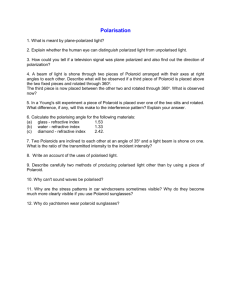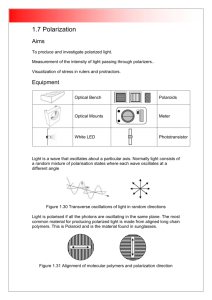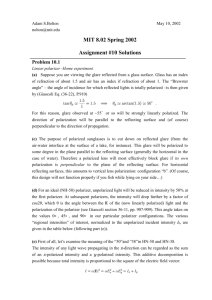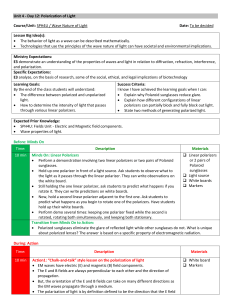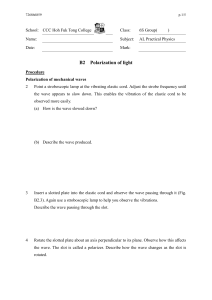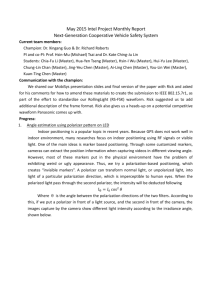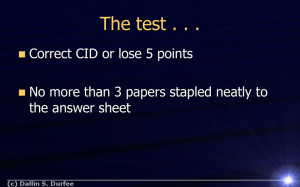POLARIZED LIGHT
advertisement
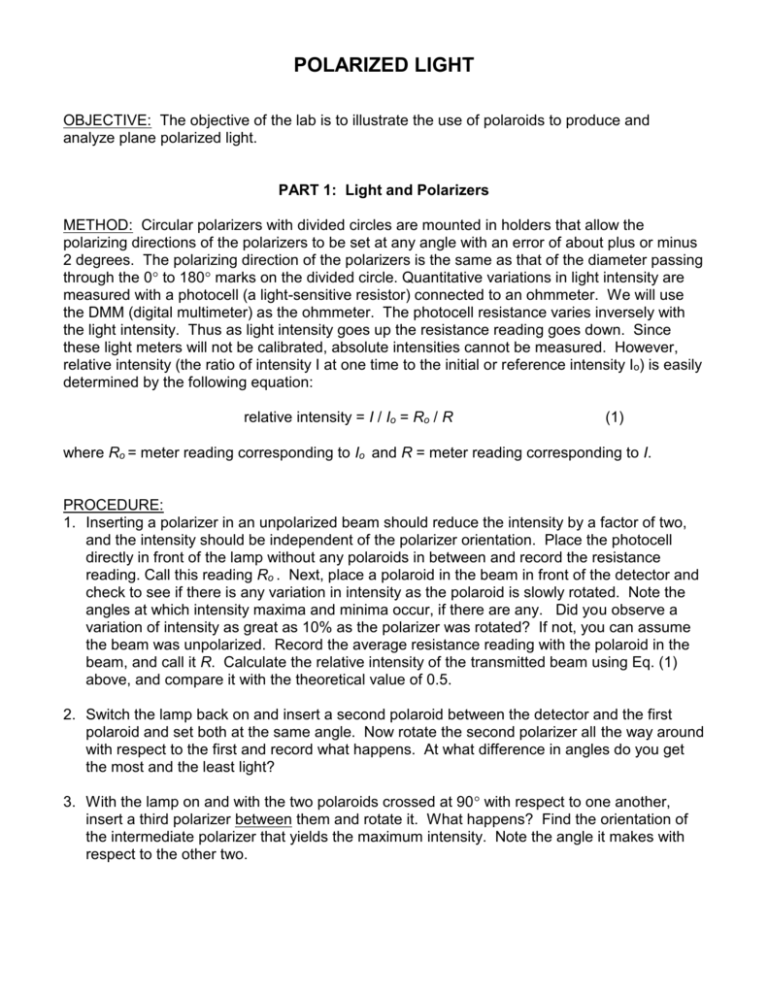
POLARIZED LIGHT OBJECTIVE: The objective of the lab is to illustrate the use of polaroids to produce and analyze plane polarized light. PART 1: Light and Polarizers METHOD: Circular polarizers with divided circles are mounted in holders that allow the polarizing directions of the polarizers to be set at any angle with an error of about plus or minus 2 degrees. The polarizing direction of the polarizers is the same as that of the diameter passing through the 0 to 180 marks on the divided circle. Quantitative variations in light intensity are measured with a photocell (a light-sensitive resistor) connected to an ohmmeter. We will use the DMM (digital multimeter) as the ohmmeter. The photocell resistance varies inversely with the light intensity. Thus as light intensity goes up the resistance reading goes down. Since these light meters will not be calibrated, absolute intensities cannot be measured. However, relative intensity (the ratio of intensity I at one time to the initial or reference intensity Io) is easily determined by the following equation: relative intensity = I / Io = Ro / R (1) where Ro = meter reading corresponding to Io and R = meter reading corresponding to I. PROCEDURE: 1. Inserting a polarizer in an unpolarized beam should reduce the intensity by a factor of two, and the intensity should be independent of the polarizer orientation. Place the photocell directly in front of the lamp without any polaroids in between and record the resistance reading. Call this reading Ro . Next, place a polaroid in the beam in front of the detector and check to see if there is any variation in intensity as the polaroid is slowly rotated. Note the angles at which intensity maxima and minima occur, if there are any. Did you observe a variation of intensity as great as 10% as the polarizer was rotated? If not, you can assume the beam was unpolarized. Record the average resistance reading with the polaroid in the beam, and call it R. Calculate the relative intensity of the transmitted beam using Eq. (1) above, and compare it with the theoretical value of 0.5. 2. Switch the lamp back on and insert a second polaroid between the detector and the first polaroid and set both at the same angle. Now rotate the second polarizer all the way around with respect to the first and record what happens. At what difference in angles do you get the most and the least light? 3. With the lamp on and with the two polaroids crossed at 90 with respect to one another, insert a third polarizer between them and rotate it. What happens? Find the orientation of the intermediate polarizer that yields the maximum intensity. Note the angle it makes with respect to the other two. Polarized Light 2 REPORT: 1. Is the lamp light polarized? 2. By how much is the intensity of the light reduced by one polarizer? 3. Describe what happens when two polarizers are used. 4. Describe what happens when three polarizers are used, particularly when the first and third are crossed at 90 while the middle one is varied. PART 2: Reflected light, glare, and Polaroid sunglasses PROCEDURE: To observe polarization by reflection, first look at the reflection of the room lights by the desk. Then look at this reflection through a polaroid. Note that as you rotate the polaroid, the reflected glare is preferentially reduced at one orientation of the polaroid. Now let's use the laser to look at this more closely. Place a polaroid in the beam to plane polarize it. Next, stand a glass plate on its edge in the polarized beam. Rotate the glass plate about a vertical axis and look for a position at which the reflected beam vanishes (or almost vanishes). Try various orientations of the polarizer until you obtain no reflection. The angle of incidence when this condition is obtained is called the BREWSTER angle. Measure the Brewster angle. With the glass plate at the Brewster angle, but without the initial polarizer in place, insert a polaroid in the reflected beam and show that it is polarized. Check to see if the transmitted beam is polarized. REPORT: 1. Is reflected light polarized? 2. Describe why polaroid sunglasses reduce glare.



